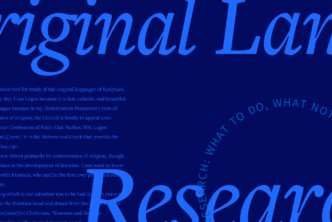It used to be that I would just check the top-rated commentary first, and that I might check the Baker Exegetical Commentary (for NT books) summary boxes for a quick run-down of a passage.
But my team at Lexham Press has produced something new that I am now turning to as my first commentary in both of the situations I just mentioned.
The Lexham Context Commentary
The brand-new Lexham Context Commentary: New Testament provides students of the Bible with quick access to the context of any portion of the New Testament. Literary scholar Leland Ryken provides introductions to major sections of the NT, then the commentary carefully outlines each book and then offers summaries of every portion of those books, at every level of the book’s outline. The commentary constantly asks, Where have we been, where are we, and where are we going? It is, then, a Context Commentary.
A given book—say, 1 Peter—may have three divisions.
- Jesus and the Foundations of a New Community (1:1–2:10)
- Practical Christian Living Even in the Midst of Suffering (2:11–4:11)
- Christian Ethics in Both Suffering and the Church (4:12–5:14)
That first division of 1 Peter contains four sections:
- Jesus and the Foundations of a New Community (1:1–2:10)
- Greeting (1:1–2)
- A Heavenly Inheritance (1:3–12)
- Living Before God Our Father (1:13–25)
- The Chosen Stone and His Chosen People (2:1–10)
That second section, for example, has within it two paragraphs.
- Jesus and the Foundations of a New Community (1:1–2:10)
- Greeting (1:1–2)
- A Heavenly Inheritance (1:3–12)
- A Secured Salvation in the Midst of Suffering (1:3–9)
- The Prophets Inquire into and Testify about This Salvation (1:10–12)
Paragraphs in the commentary divide into two or more verses (verses are sometimes combined in the commentary into what could be called, for lack of a technical term, “units”).
At each of these levels up and down the hierarchy of the outline, the Lexham Context Commentary provides a summary statement explaining the context. Generally this means answering the questions of 1) where the writer has been, 2) where the writer is, and 3) where the writer is going. (Sometimes, in order to avoid repetition from adjoining discussions, the first and third questions may not be addressed.)
For example, the comment on the paragraph at 1 Peter 1:10–12 offers a summary heading and then a guide to understanding the paragraph’s place in Peter’s flow of thought.
The Prophets Inquire into and Testify About This Salvation (1:10–12)
The key word “salvation” in 1:9 and 1:10 functions as a hook word that joins these two different paragraphs together (1:3–9 and 1:10–12). The salvation that functions as the goal, or telos, of the believer’s faith is the very same salvation that the prophets spoke of and inquired into. Indeed, those prophets served not themselves but Peter’s own generation, and even angels desire to better understand the ramifications of such a great salvation. The focus of 1:10–12, then, is on how the salvation of believers fits into ancient prophecy.
A subsequent note on the third section of the book shows where Peter’s argument has come from and where it is going. It offers some mental hooks for the reader to hang onto while reading the section—namely, look for the four key imperatives:
Living Before God Our Father (1:13–25)
The opening “therefore” indicates a new segment building off the previous material. Four imperatives (“hope,” “be holy,” “live,” and “love”) hold this section together and thus link ethics to theology. In light of their privileged place in salvation history, believers are expected to live a certain way.
Many other valid angles exist from which to view the Bible. A commentary might focus on the socio-historical background of the text, or it might pay special attention to Greek or Hebrew word forms. It might aim to get quickly to expansive applications or accessible illustrations. The Lexham Context Commentary focuses—at multiple “zoom” levels (from forest to trees to branches)—on the literary context. This is usually the first thing I need when looking at commentaries: the “forest” view rather than the “tree” or “twig” view.
When and how to use the Lexham Context Commentary
Perhaps you are teaching a Bible lesson on 1 Thessalonians 5 and you notice that Paul’s counsel to “keep awake and be sober” mirrors that of Jesus in Matthew 24:42. You check the cross-reference in Matthew but then realize—This is the sometimes difficult Olivet Discourse; I want to make sure I understand how Jesus’ command to “keep awake” functions in that context. You do not have time to do a deep commentary dive on that long and demanding passage; you need a quick rundown of the context. So you turn to the Lexham Context Commentary. You look for guidance on 1) where Jesus has been, 2) where Jesus is, and 3) where he is going in the comments on Matt 24:42. This is what you get:
24:42 From the preceding discussion about the sudden coming of the hour of his second coming [this is where Jesus has been], Jesus commands his disciples to be alert, because they do not know the day of the Lord’s coming [this is where Jesus is—now you will receive some help seeing where he is going]. This is the first command in this passage, with the next to “be ready” in 24:44. The commands to the redeemed community are not about discerning or watching for signs, but about a state of readiness and faithfulness. These commands will be further expressed and encouraged in a small parable about a thief in the next verse and in the next three longer parables that follow. The language of “the lord” and “coming” in this verse anticipates the parable in the next passage (24:45–51).
This is helpful: Jesus in his four parables has just given you several illustrations to use for your lesson on 1 Thessalonians 4. Read Matthew 24:42 by itself and you will miss some excellent opportunities to expand your understanding and that of those you teach. By quickly checking the context of that cross-reference, you can come back to your main passage with greater understanding. A close reader of the text has already pointed out the important tie between Jesus’ command to “keep awake” and the surrounding illustrative material.
You can dip into the context of any New Testament book at any level of the outline of that book. Read a summary of just a paragraph or a verse; read a summary of a longer passage that includes those paragraphs and verses; read a summary of an entire New Testament book. The commentary does provide magnifying glasses for staring intently at a tree, but I think you’ll use it more commonly as a hot air balloon to fly up above the forest, or at least the copse or grove you’re in.
The Lexham Context Commentary does not get bogged down with the kinds of minute details that are appropriate for other, longer, technical commentaries. The commentary is useful for a sort of dedicated, careful skimming when that is what you need—and it allows you to skim at various levels of a book’s organization.
The image below shows how the commentary is organized, from the highest levels of the outline to the most narrow. Heading styles indicate the hierarchical levels from Book to Division and down to Verse/Unit.
***
The brand-new Lexham Context Commentary is a perfect addition to your Logos library. Pick up your copy now!







